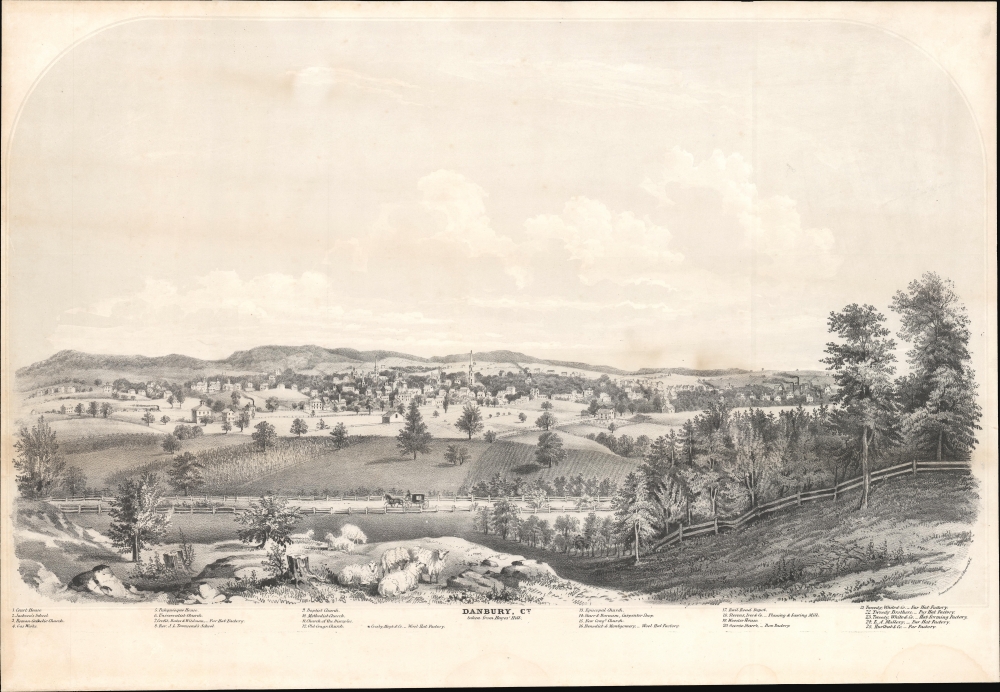This item has been sold, but you can get on the Waitlist to be notified if another example becomes available, or purchase a digital scan.
1858 Hayward Bird's-Eye View of Danbury, Connecticut as a Hatter's Center
Danbury-hayward-1858
Title
1858 (undated) 15.25 x 22 in (38.735 x 55.88 cm)
Description
A Closer Look
The low-oblique view looks westward on Danbury from Hayes' Hill, a highpoint east of the city center. In the foreground sheep lounge on a bucolic hillside, while a post chaise carriage trundles along a fenced country lane. Bountiful fields spread out behind, eventually giving way to the urban center of Danbury. Soaring steeples represent the New Congregational Church and the Methodist Church, numbers 15 and 10, respectively. Some 25 locations are identified numerically, quite a few of which emphasize Danbury's history as a hat-making center.Hat City
In the 19th century, Danbury, Connecticut, solidified its reputation as the 'Hat City,' becoming a notable center for hat making in the United States. The hat industry's roots in Danbury can be traced back to 1780, but it was during the 1800s that the city experienced a period of remarkable growth. With proximity to major waterways and the New York markets, Danbury was ideally positioned for the industry, and the city saw a dramatic increase in the number of hat factories, making it the nation's foremost producer. At its peak, Danbury was producing more than 5 million hats per year, drawing labor from not just the local population, but also immigrants from Europe who brought skilled craftsmanship, transforming the city into the epicenter of American hat manufacturing. The impact of this industry was so substantial that it significantly shaped Danbury's economic, social, and cultural landscapes during the 19th century.American Bird's-Eye City Views
The tradition of the bird's-eye city view emerged in the United States in the middle part of the 19th century and coincided with the commercial development of lithographic printing. Before the rise of lithography, the ability to own and display artwork in the home was largely limited to the extremely wealthy, the advent of lithographic printing made it possible for everyone to own visually striking artwork. A robust trade developed in portraits of political leaders, allegorical and religious images, and city views.City views were being produced in the United States as early as the 1830s, but the genre exploded after the American Civil War (1861 - 1865). Bridging the gap between maps and pictures, most 19th century American bird's-eye views presented cities to the public from high vantage points. Some were imagined, but others were drawn from hot-air balloons or nearby hills. The presentation, combining high elevation, commercial interest, and new printing technology, created a uniquely American art form, as described by historian Donald Karshan
Some print connoisseurs believe that it was only with the advent of the full-blown city-view lithograph that American printmaking reached its first plateau of originality, making a historical contribution to the graphic arts. They cite the differences between the European city-view prints and the expansive American version that reflects a new land and a new attitude toward the land.The vogue for bird's-eye city views lasted from about 1845 to 1920, during which period some 2,400 cities were thus portrayed, some multiple times. Although views were produced in many urban centers, the nexus of view production in the United States was Milwaukee, Wisconsin. The major American viewmakers were Stoner, Wellge, Bailey, Fowler, Hill, Ruger, Koch, Burleigh, Norris, and Morse, among others.
Publication History and Census
This view was drawn and engraved by the New York artist and lithographer George Hayward. It was published around 1858. We see no publisher identified, but Reps points to C. E. Smith and Van Zandt of New York. Very Rare. Reps notes but one example, located in the Danbury Scott-Fanton Museum and Historical Society. Not in OCLC.Cartographer
George Hayward (fl. c. 1850 - 1870) was an American lithographer based in New York City in the middle to late 19th century. Hayward's imprint appears on numerous 19th century maps associated with the Manual of the Corporation of New York, published at various times by David T. Valentine and Joseph Shannon. He also did similar work for William Bishop and Henry McCloskey of Brooklyn. He was involved in various partnerships, publishing at various times as Hayward, States and Koch (171 Pearl Street), Hayward and Lepine (171 Pearl St). Today he is memorialized by Heyward Street in South Williamsburg, Brooklyn. More by this mapmaker...

